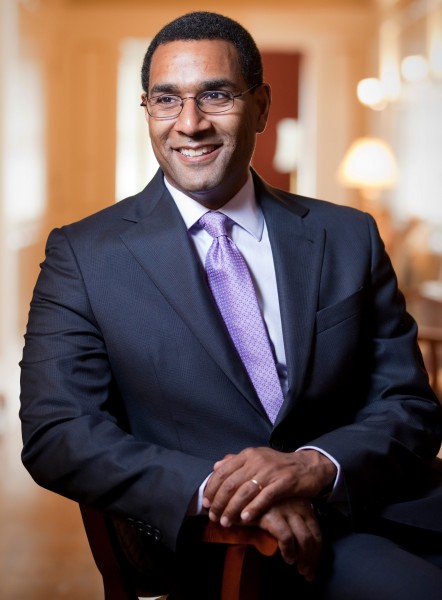A Letter from President Decatur
 A Vision for Kenyon
A Vision for Kenyon
Since moving to Gambier in July, I have developed the habit of taking a daily, morning walk around the campus. Over the course of the past few months, I have experienced the postcard-perfect Kenyon through the seasons. During the summer, the campus was fairly quiet, with green trees and lowering shrubs; in the fall, the leaves along Middle Path were a mix of greens, yellows, and reds, with a cool mist in the air and traces of fog around Ascension and Old Kenyon; and this morning the first snow coats the lawn.
During my first quarter as president of Kenyon College, much of my time and energy have been spent getting to know the campus and the extended Kenyon community. I have spent time with members of the Gambier and Mount Vernon communities, from Village Council meetings to summer barbecues at the Kenyon Inn to meetings of the local Rotary and Kiwanis clubs. I have met students in the residence halls (including helping a few families during move-in), at Cromwell (hosting weekly, evening meetings with student groups), as an academic advisor, on the athletic fields, and in the theaters. I have joined faculty and staff in visits to departments and divisions across campus, met promising new faculty as well as the great, old lions, and held monthly open forum sessions to meet, greet, and answer questions. And I have been delighted to engage with alumni in Cleveland, Columbus, New York, Washington, and Richmond – the first legs of a major cities tour.
In all of these interactions, my goals have been to meet, to listen, and to learn. Kenyon is a place where history, tradition, and community matter, and, as a newcomer, my first chore has been to immerse myself in all three.
Learning about Kenyon
After about five months into my presidency, this is an appropriate moment to take stock and report on what I have learned and observed:
1. First and foremost, Kenyon is an institution in a very strong position. Our physical plant is stunning (with a nationally recognized campus). Direct measures of our market position, including our ability to attract students (i.e., numbers of applications and yield) and our ability to retain them (graduation rates and retention rates) are robust. We succeed at attracting students, and, after they come, we guide them to graduation. Our overall financial position is very solid. We have been a prudently managed institution, yet one that has been in a position to take advantage of opportunity.
2. Perhaps our most valuable asset is the passion that members of the Kenyon community feel for the school. This passion runs high among students, faculty, staff, alumni, and parents. We should appreciate that this is not the norm – passions about Kenyon are stronger than those at any other institution where I’ve been a faculty member or administrator. This loyalty puts us in a solid position to maintain and advance campus morale, alumni engagement, and philanthropic enthusiasm.
3. This is a school that puts student learning at its center and where every member of the staff – from the recycling center to our safety office, from the residential life program to the Kenyon Athletic Center – quickly cites student learning as the reason they are here. This deep recognition and commitment to institutional mission throughout is something special and deserving of appreciation. Not many institutions embrace their mission with this degree of clarity and depth of passion. And our faculty comprises an outstanding group of teacher-scholars, dedicated to their students, creative in the craft of teaching, and productive in the generation of new knowledge.
4. We have amazing assets in the Kenyon Review, Gund Gallery, and Philander Chase Corporation. Indeed, one could think of Kenyon as a constellation of distinctive entities, including not only these, but also the Center for Study of American Democracy and the Brown Family Environmental Center. With the unique service opportunities offered to students, all of these contribute to creating an experience at Kenyon that is distinctive among liberal arts colleges.
The Path Going Forward
Despite our position of strength, there are changes on the broader higher education landscape that loom large: the impact of technology on student learning and educational options; the challenges of controlling costs and making a Kenyon education accessible to talented students of all income levels; changing national demographics, which will make the competition for talented students even sharper; and the compelling need to bridge the core liberal arts education to success after graduation. While we face these challenges from a good position, we cannot rest on our laurels or ignore the work that must be done.
As I move from my first quarter at Kenyon into my second, I am transitioning from listening and learning to moving forward with a clear vision and a comprehensive planning process. The fundamental questions are these: What do we envision as important and essential for the Kenyon of 2020? What are the challenges, internal and external, that we face to achieve this vision? And what are the strategic priorities that should guide our thinking as we move toward this vision? We will find the answers through a comprehensive planning process, driven by data and analysis, and inclusive of all voices in the community. The result will be a clear road map for Kenyon for the next six years.
My morning walks around the campus have accelerated my love of Kenyon – not only the beauty, but also our students, our community, our institution, and our mission. I am excited about the work that lies ahead for all of us, and I look forward to the bright future that we will share.
Sean M. Decatur
President
Kenyon College